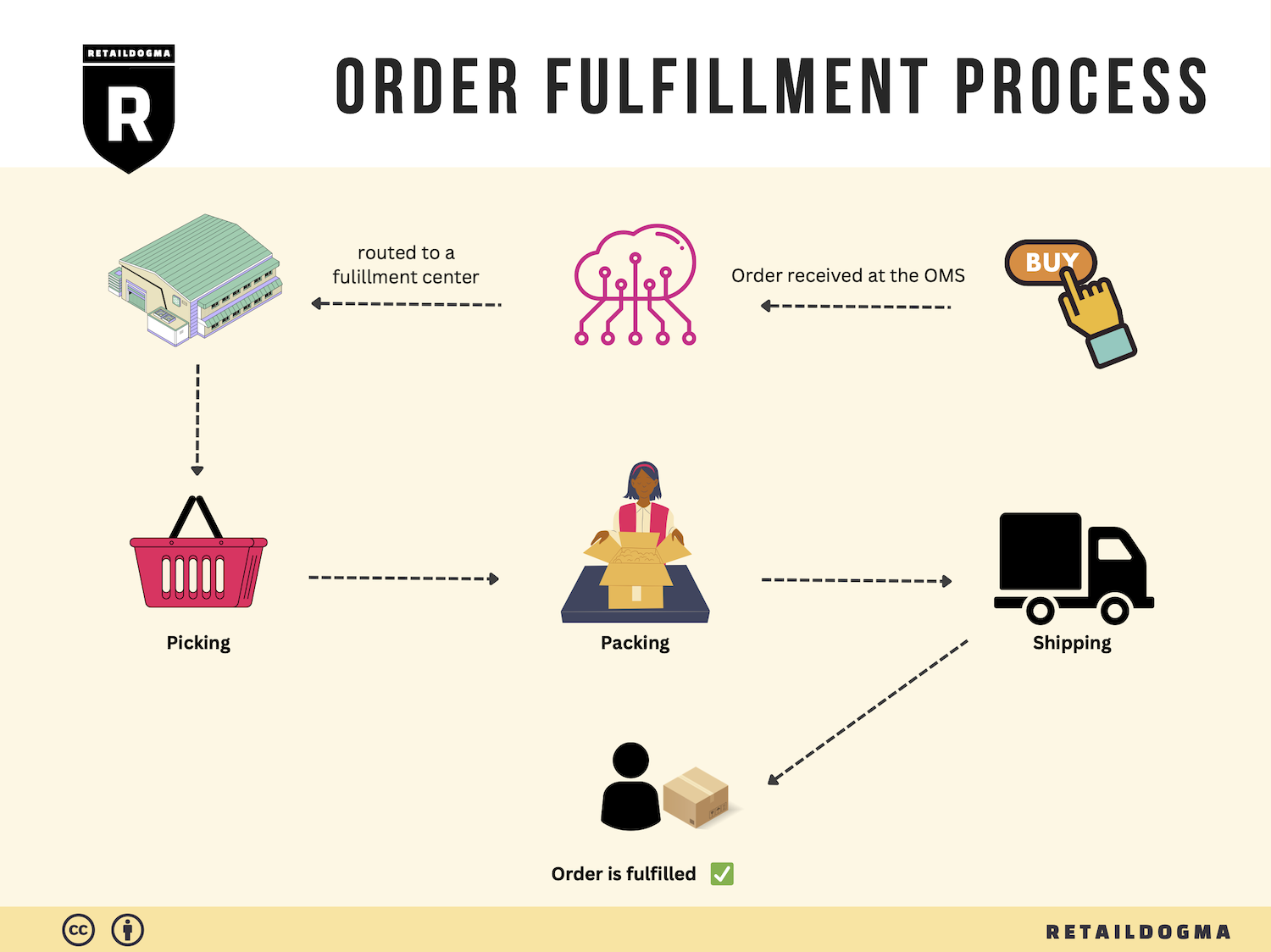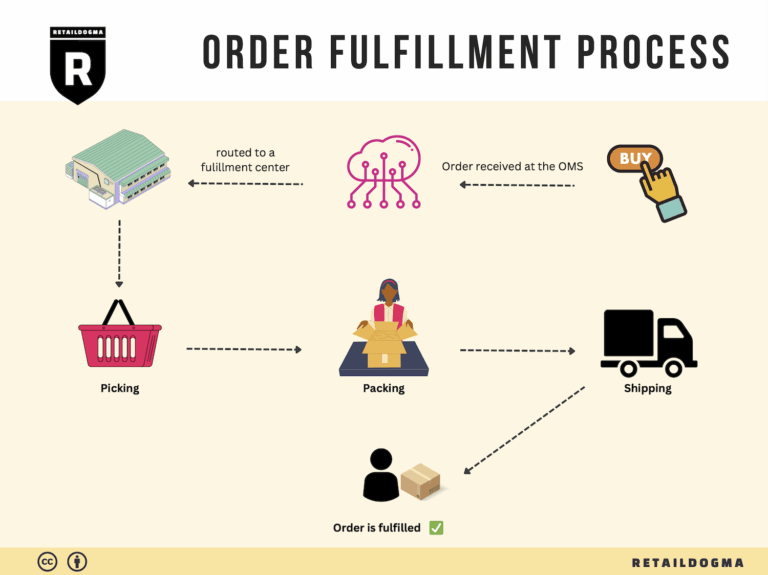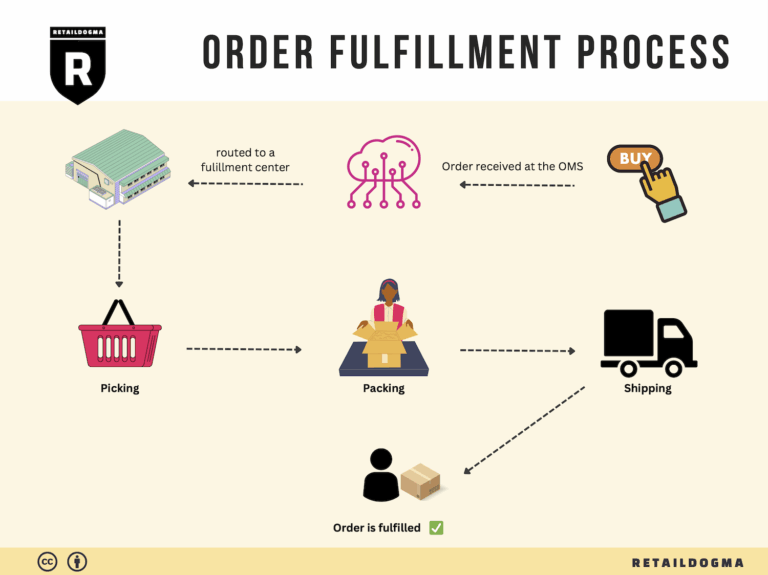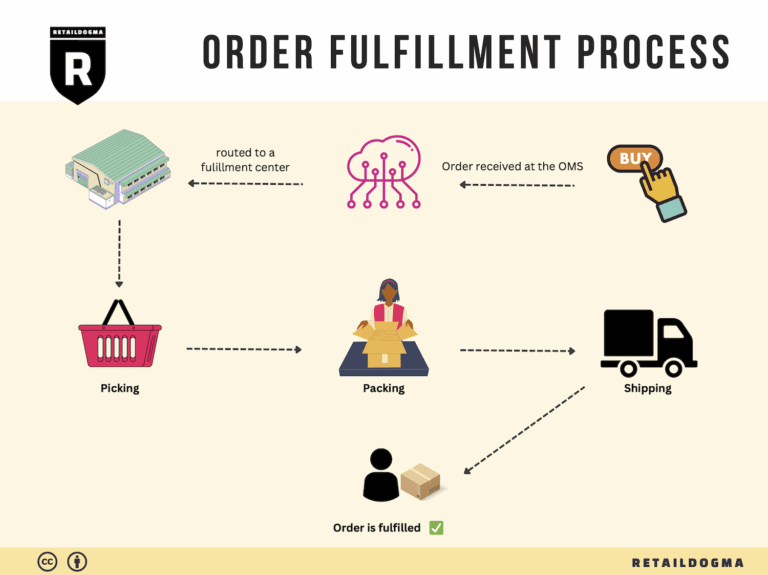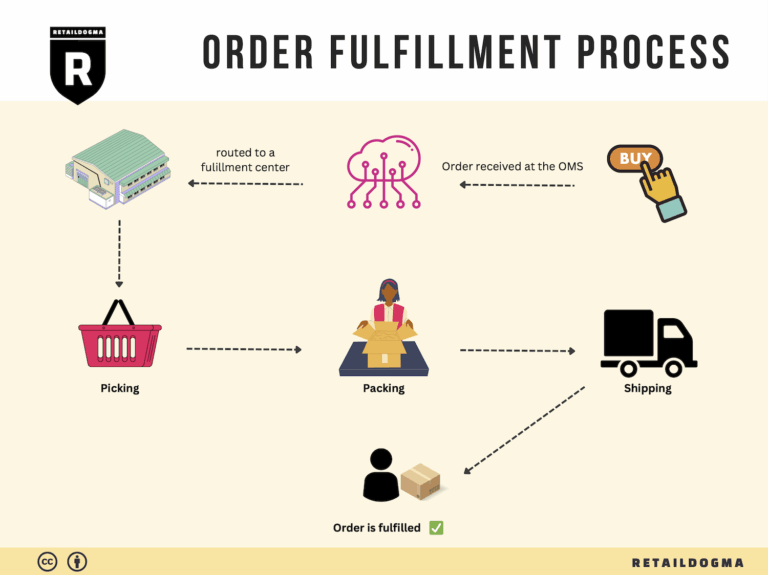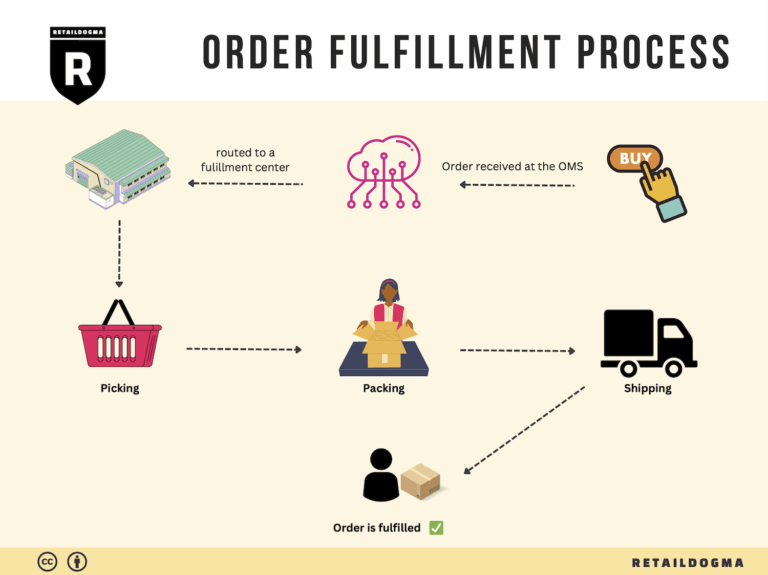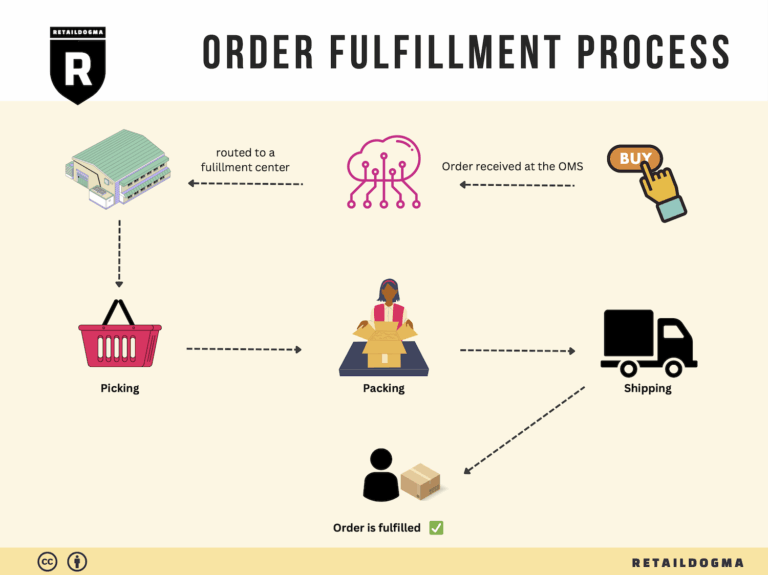How Order Fulfillment Works: A Step-by-Step Guide for Businesses
What is E-commerce Fulfillment? An Introduction for Growing Businesses
Understanding E-commerce Fulfillment
As an e-commerce business owner, one of the most common challenges you may face is the overwhelming task of packing and shipping orders. As your sales grow, so does the complexity of fulfilling those orders accurately and efficiently. This is where e-commerce fulfillment comes into play. Simply put, fulfillment is the process of getting a product from your inventory to your customer’s doorstep. It encompasses everything from receiving inventory and storing products to picking, packing, and shipping orders.
For many growing businesses, the fulfillment process can quickly become a bottleneck. You might find yourself spending countless hours managing logistics instead of focusing on scaling your operations and enhancing customer experience. This guide aims to demystify e-commerce fulfillment, providing you with the knowledge and tools to optimize this crucial aspect of your business.
What This Guide Covers
In this guide, we will explore various fulfillment models available to e-commerce businesses, including Third-Party Logistics (3PL) and Fulfillment by Amazon (FBA). Each model has its own advantages and disadvantages, depending on your business needs and growth trajectory.
We will delve into the core services involved in fulfillment, such as inventory management, order processing, shipping, and returns handling. Understanding these services will help you identify what your business requires to streamline operations and improve customer satisfaction.
Choosing the right fulfillment partner is another critical aspect we will cover. We’ll provide you with practical tips on what to look for in a fulfillment provider, including their capabilities, technology integration, customer service, and performance metrics. This section will empower you to make informed decisions that align with your business goals.
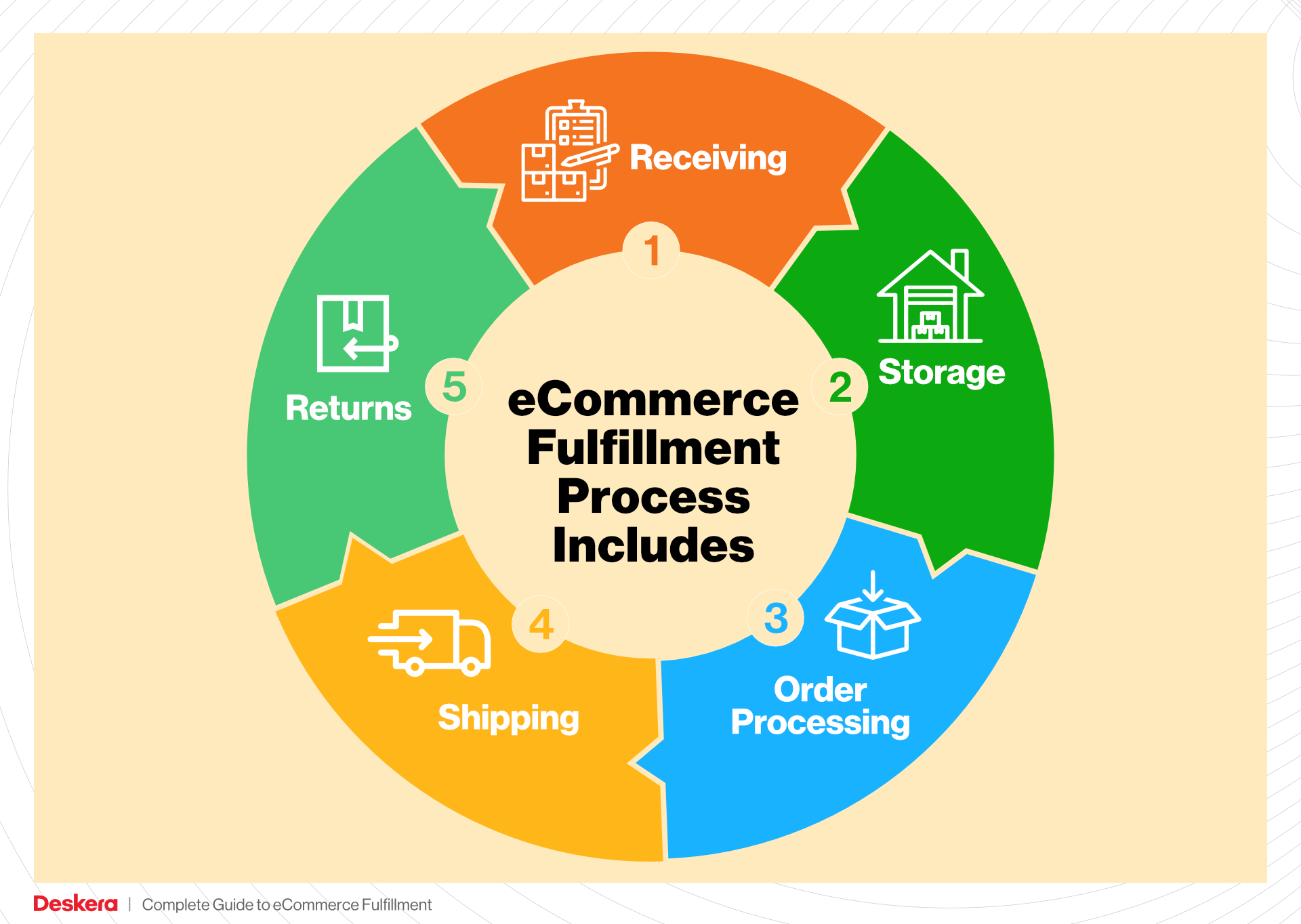
Finally, we will discuss pricing models in fulfillment, helping you understand how costs are structured and what factors influence pricing. Knowing how to budget for fulfillment can significantly impact your bottom line and overall profitability.
Empowering Smart Logistics Decisions
Our goal with this guide is to empower you to make informed decisions about your logistics operations. By providing insights into fulfillment processes, models, and partner selection, we aim to help you transition from feeling overwhelmed to having a clear strategy for efficient order fulfillment. With the right approach, you can enhance your operational efficiency, improve customer satisfaction, and ultimately drive your business growth.
What You’ll Learn In This Guide
- What is E-commerce Fulfillment? An Introduction for Growing Businesses
- The Order Fulfillment Process: From ‘Buy’ Button to Customer’s Door
- Comparing Fulfillment Models: In-House vs. 3PL vs. Dropshipping
- A Deep Dive into Amazon FBA: Pros, Cons, and Who It’s For
- Core Services Offered by Fulfillment Centers
- How to Choose a Fulfillment Partner: A 6-Point Checklist
- Understanding Fulfillment Pricing: A Breakdown of Common Fees
- Frequently Asked Questions (FAQs) about Fulfillment
- Conclusion: Is Outsourcing Fulfillment the Right Move for Your Business?
- Important Disclaimer
The Order Fulfillment Process: From ‘Buy’ Button to Customer’s Door
1. Receiving Inventory
The order fulfillment process begins with receiving inventory, a crucial step that sets the stage for efficient operations. When products arrive at the fulfillment center, they undergo a thorough inspection to ensure they meet quality standards and match the purchase orders. This involves checking for discrepancies in quantities and conditions, as well as verifying that the correct items have been delivered.
Why It’s Important: Accurate receiving minimizes errors that can lead to stockouts or excess inventory, both of which can negatively impact customer satisfaction and operational efficiency. Efficient inventory management begins here, ensuring that only the right products are stored for future orders.
Key Term: SKU (Stock Keeping Unit) – A unique identifier for each product, which simplifies the tracking and management of inventory.
2. Warehouse Storage
Once inventory is received and verified, it is stored in the fulfillment center. Proper warehouse storage is critical for maximizing space utilization and ensuring quick access to products when orders are placed. Items are typically organized based on various strategies, such as by category, size, or turnover rate, to facilitate efficient picking.
Why It’s Important: Effective warehouse storage reduces the time required to locate items during the picking process, which in turn speeds up order fulfillment. This organization helps maintain inventory accuracy and supports better inventory planning.
Key Term: ABC Analysis – A categorization technique that prioritizes inventory based on importance, allowing businesses to focus on high-value items while managing storage costs effectively.
3. Order Picking
When a customer clicks the ‘Buy’ button, the order picking process is initiated. This step involves retrieving the items from storage based on the incoming order. Fulfillment centers often use pick lists, which are detailed documents listing the items and quantities needed for each order. Depending on the volume and complexity of the orders, picking can be done using various methods, such as single order picking or batch picking.
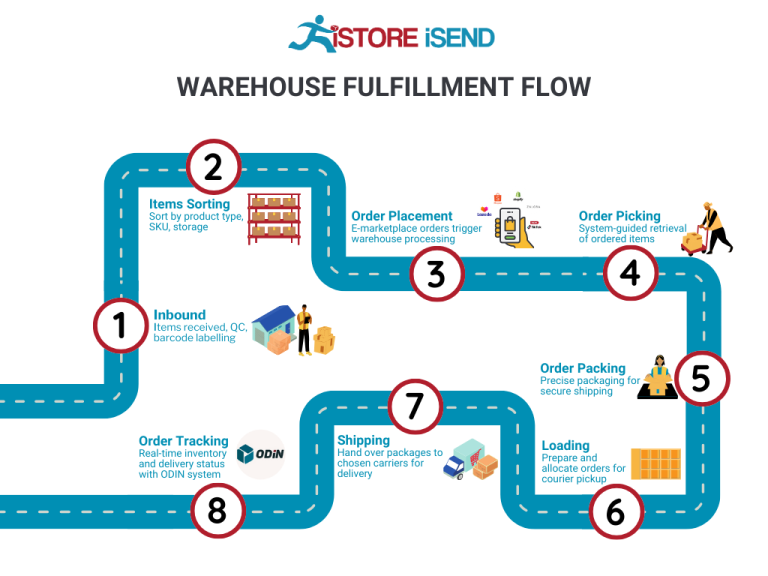
Why It’s Important: The accuracy and speed of order picking directly impact fulfillment efficiency and customer satisfaction. Errors during this stage can lead to incorrect shipments, which can damage customer trust and increase return rates.
Key Term: Pick Lists – Documents or digital records that guide warehouse staff in locating and retrieving the correct items for fulfillment.
4. Order Packing
After items are picked, they move to the packing stage. Here, products are carefully packaged to ensure they arrive safely at the customer’s door. This involves selecting appropriate packing materials and boxes, as well as including necessary documentation such as packing slips or return instructions. Some fulfillment centers may also offer value-added services like kitting, where multiple items are bundled together for shipping.
Why It’s Important: Proper packing not only protects products during transit but also enhances the unboxing experience for customers. Thoughtful packaging can reinforce brand identity and encourage repeat purchases.
Key Term: Kitting – The process of assembling multiple products into a single package or kit, which can streamline shipping and enhance customer satisfaction.
5. Shipping & Delivery
The final step in the order fulfillment process is shipping and delivery. Once an order is packed, it is labeled and dispatched to the chosen carrier for delivery. Fulfillment centers often have partnerships with major shipping carriers to provide a range of shipping options, including same-day shipping or expedited services. Tracking capabilities are also essential, allowing customers to monitor their order’s journey.
Why It’s Important: Timely and accurate shipping is critical for customer satisfaction. Fast delivery not only meets customer expectations but also helps reduce cart abandonment and improves the overall shopping experience.
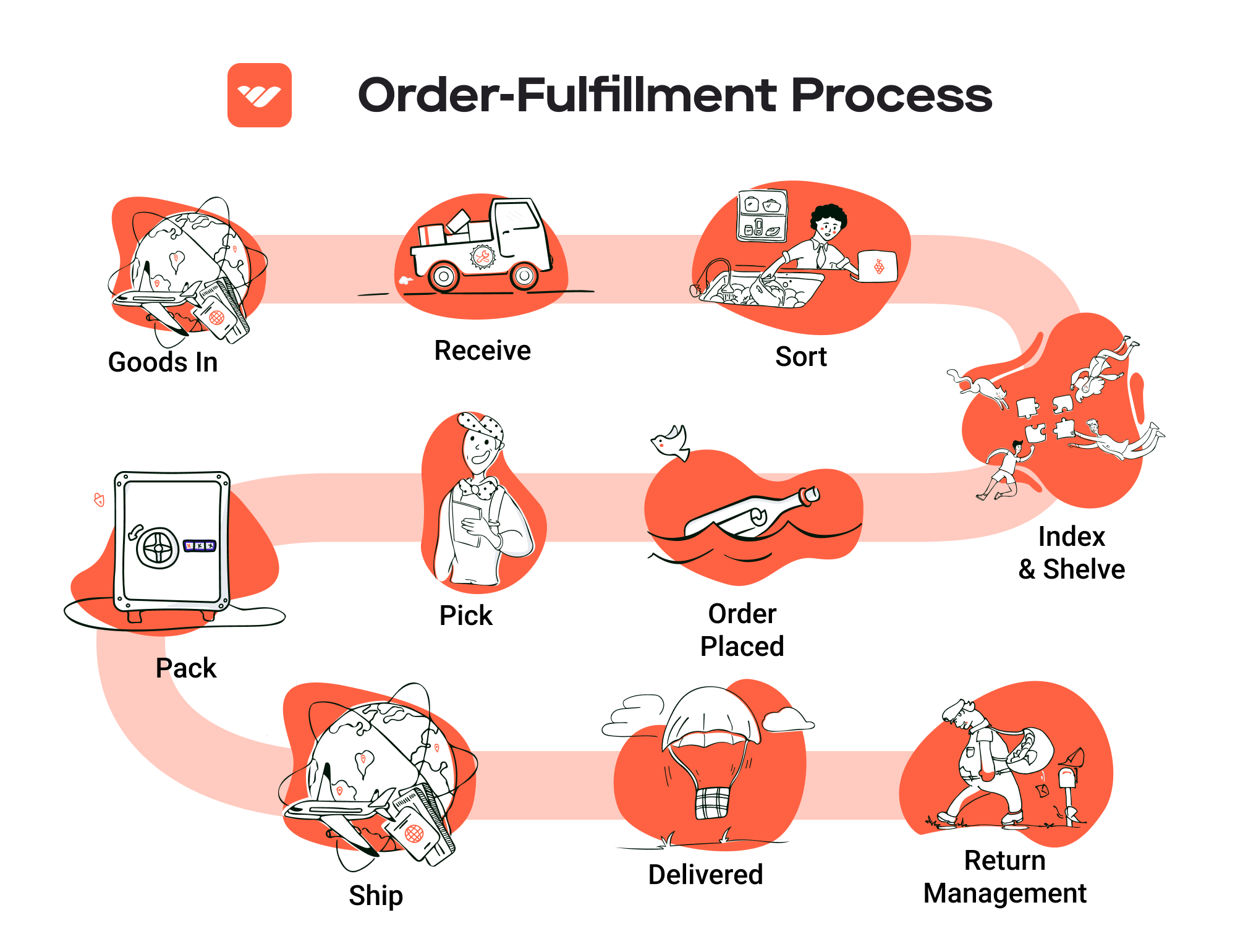
Key Term: Carrier Management – The process of selecting and managing relationships with shipping carriers to optimize shipping costs and delivery times.
By understanding and optimizing each step of the order fulfillment process, e-commerce businesses can significantly improve their operational efficiency, reduce costs, and enhance customer satisfaction, ultimately driving growth and scalability in their operations.
Comparing Fulfillment Models: In-House vs. 3PL vs. Dropshipping
Fulfillment Model Comparison
| Model | Who Handles Inventory | Best For (Business Stage) | Key Advantage | Key Disadvantage |
|---|---|---|---|---|
| In-House Fulfillment | The e-commerce business itself | Established brands with high volume | Complete control over inventory and operations | High overhead costs and resource-intensive |
| Third-Party Logistics (3PL) | A third-party provider (like Red Stag Fulfillment) | Growing brands looking to scale | Reduced burden on operations and expert support | Less control over logistics and potential misalignment with business goals |
| Dropshipping | Supplier or manufacturer | Startups or those testing markets | Low upfront investment and no inventory holding | Lower profit margins and reliance on suppliers |
In-House Fulfillment
In-house fulfillment involves managing all aspects of warehousing, inventory management, and order processing within your own facilities. This model is best suited for established brands that have significant order volumes and want to maintain complete control over their logistics operations. The key advantage of in-house fulfillment is the ability to oversee every step of the process, from inventory management to packing and shipping. This direct control can lead to enhanced quality assurance and customer service, as businesses can tailor their operations to meet specific brand standards and customer expectations.
However, the downsides are considerable. In-house fulfillment typically comes with high overhead costs, including warehousing, labor, and technology investments. It also requires a significant commitment of time and resources, which can detract from the core business functions of marketing and sales. As businesses grow, managing logistics can become increasingly complex and resource-intensive, leading many to reconsider their fulfillment strategy.
Third-Party Logistics (3PL)
Third-party logistics (3PL) providers, such as Red Stag Fulfillment, offer outsourced warehousing, inventory management, and order fulfillment services. This model is ideal for growing brands that are looking to scale quickly without the burden of managing logistics themselves. The primary advantage of partnering with a 3PL is the reduction of operational burdens; businesses can focus on core activities such as product development and customer engagement while leaving the complexities of fulfillment to experts.
3PLs also provide valuable resources such as advanced technology, logistics expertise, and established networks that can enhance shipping efficiency and accuracy. For example, Red Stag boasts impressive metrics, including 99.99% fulfillment accuracy and the ability to reach 96% of the U.S. population within two days. However, the key disadvantage is that businesses may have less control over their logistics operations, which can lead to potential misalignment with brand values and customer expectations. Additionally, relying on a third party means that any errors or delays in fulfillment directly impact the brand’s reputation.
Dropshipping
Dropshipping is a fulfillment method where the retailer does not keep products in stock but instead transfers customer orders directly to a supplier or manufacturer, who then ships the products to the customer. This model is particularly attractive for startups or businesses testing new markets, as it requires minimal upfront investment and eliminates the need for inventory storage. The key advantage of dropshipping is that it allows entrepreneurs to start selling products without the financial risks associated with holding inventory.
However, dropshipping also comes with significant drawbacks. Profit margins are often lower compared to other fulfillment methods, as retailers typically pay a premium to suppliers for the convenience of not handling inventory. Additionally, dropshipping relies heavily on suppliers, which can lead to issues with product quality, fulfillment speed, and stock availability. If a supplier runs out of stock or fails to deliver on time, it can directly impact the retailer’s customer satisfaction and brand reputation. This reliance on external parties makes dropshipping less suitable for brands looking to establish strong customer relationships and brand loyalty.
Conclusion
Choosing the right fulfillment model is crucial for e-commerce businesses looking to scale. In-house fulfillment offers control and quality assurance but at a high cost, while 3PLs provide expertise and efficiency, allowing brands to focus on growth. Dropshipping presents a low-risk entry point into e-commerce, but it comes with challenges that can affect profitability and customer satisfaction. Each model has its strengths and weaknesses, and the best choice depends on the specific needs, goals, and stage of the business.
A Deep Dive into Amazon FBA: Pros, Cons, and Who It’s For
Understanding Fulfillment by Amazon (FBA)
Fulfillment by Amazon (FBA) is a service provided by Amazon that allows sellers to store their products in Amazon’s fulfillment centers. Amazon then takes care of storage, packaging, shipping, and customer service for these products. When a customer places an order, Amazon handles the entire fulfillment process, including returns. This enables sellers to leverage Amazon’s vast logistics network and customer service infrastructure, making it a powerful option for e-commerce businesses looking to scale.
How FBA Works
-
Setting Up: Sellers create an Amazon seller account and set up FBA by selecting which products they want to fulfill through Amazon. They prepare their products according to Amazon’s guidelines and ship them to Amazon’s fulfillment centers.
-
Storage: Once the products arrive at Amazon’s warehouses, they are stored until they sell. Sellers can monitor their inventory levels through their Amazon seller account.
-
Order Fulfillment: When a customer orders a product, Amazon picks, packs, and ships the item. The seller does not need to handle any of these logistics.
-
Customer Service: Amazon manages all customer service inquiries and returns on behalf of the seller. This includes handling questions about the product, order status, and returns.
-
Payment: After the sale, Amazon deposits the seller’s earnings into their account, deducting FBA fees, which cover storage and fulfillment services.
Pros of Fulfillment by Amazon (FBA)
-
Prime Eligibility: Products fulfilled through FBA are eligible for Amazon Prime, which can significantly increase sales. Prime members often prefer Prime-eligible products due to faster shipping options.
-
Customer Trust: Amazon is a trusted marketplace, and having FBA products can lend credibility to your brand. Customers feel more secure buying from sellers whose products are backed by Amazon’s customer service.
-
Multi-Channel Fulfillment: FBA allows sellers to utilize Amazon’s fulfillment services for orders placed outside of Amazon, such as through their own websites or other marketplaces. This helps streamline operations and inventory management across various sales channels.
-
Scalability: As sales grow, FBA can easily accommodate increased order volumes without the need for significant investments in logistics infrastructure. Sellers can focus on scaling their business without worrying about fulfillment logistics.
-
Reduced Operational Burden: FBA handles the complexities of logistics, allowing sellers to focus on marketing and product development rather than warehousing and shipping.
Cons of Fulfillment by Amazon (FBA)
-
High Fees: FBA can be costly, especially for small or low-margin products. Fees include storage fees for inventory held at Amazon warehouses and fulfillment fees for each order shipped. These costs can eat into profit margins.
-
Strict Inventory Rules: Amazon has strict guidelines regarding inventory management, including limits on how much inventory can be stored. This can be challenging for sellers who experience fluctuations in demand.
-
Commingling Risks: FBA products may be commingled with those from other sellers, which can lead to issues if customers receive the wrong item or if there are quality control problems. This can damage a seller’s reputation if not managed properly.
-
Loss of Control: When using FBA, sellers relinquish some control over the fulfillment process, including how products are handled and packaged. Any mistakes made by Amazon can impact the seller’s reputation.
-
Complex Returns Process: While Amazon manages returns, sellers may face challenges, such as difficulty in understanding return reasons or dealing with lost or damaged inventory.
Who is FBA Best For?
Fulfillment by Amazon is ideally suited for:
-
High-Volume Sellers: Businesses with significant sales volume can benefit from FBA due to its efficient logistics and fast shipping options. The ability to scale operations without additional investment in warehousing makes it attractive.
-
Small to Medium-Sized Enterprises (SMEs): SMEs looking to leverage Amazon’s customer base and logistics network can find FBA a practical solution. It allows them to compete with larger brands without the same level of infrastructure.
-
Product Categories with High Demand: Sellers with products that have consistent demand or seasonal spikes can benefit from FBA’s ability to handle fluctuating inventory levels effectively.
-
Brands Seeking Brand Trust: New or lesser-known brands can gain customer trust by selling through FBA, as customers often prefer buying products that come with Amazon’s backing and customer service.
-
Sellers Focused on Growth: Entrepreneurs looking to focus on marketing and growing their business rather than logistics will find FBA appealing, as it frees them from the operational burdens of order fulfillment.
In summary, Fulfillment by Amazon can be a powerful tool for e-commerce businesses looking to expand their reach and simplify their logistics. However, it’s crucial for sellers to weigh the pros and cons carefully and assess whether it aligns with their business model and growth objectives. By understanding how FBA works and its implications, businesses can make informed decisions that best suit their operational needs and strategic goals.
Core Services Offered by Fulfillment Centers
Inventory Management & Warehousing
Inventory management and warehousing are foundational services provided by fulfillment centers, designed to ensure that your products are stored safely and efficiently. Fulfillment centers like Red Stag Fulfillment utilize sophisticated inventory management systems that allow for real-time tracking of stock levels, SKU counts, and order statuses. This ensures that businesses can maintain optimal inventory levels, reducing the risk of stockouts or excess inventory.
The benefits of effective inventory management are manifold. Firstly, it allows e-commerce businesses to respond swiftly to market demand, fulfilling orders promptly and maintaining customer satisfaction. Additionally, accurate inventory tracking minimizes the chances of overstocking, which can lead to increased storage costs and potential markdowns. By leveraging the expertise of a fulfillment center, e-commerce brands can focus on scaling their operations while leaving the complexities of inventory management to seasoned professionals.
Pick and Pack Services
Pick and pack services are critical for e-commerce operations as they encompass the processes of selecting items from inventory (picking) and packaging them for shipment (packing). Fulfillment centers employ streamlined processes and technology to ensure that orders are fulfilled accurately and efficiently. This includes using barcodes and scanning systems to verify items as they are picked, ensuring that the correct products are packaged for shipment.
The primary benefit of effective pick and pack services is enhanced order accuracy. For e-commerce businesses, each mispick can lead to customer dissatisfaction and increased return rates. Fulfillment centers often achieve near-perfect accuracy rates, as seen with Red Stag’s impressive metrics. This reliability translates into happier customers and fewer operational headaches for businesses. Furthermore, using a fulfillment center allows businesses to scale their operations without the need to invest heavily in their own warehousing and staffing, enabling them to grow more efficiently.
Kitting and Assembly
Kitting and assembly are value-added services that allow e-commerce businesses to offer bundled products or customized kits to their customers. This process involves assembling individual items into a single package or kit before shipping. For example, a company selling a DIY craft kit would benefit from having its fulfillment center gather all necessary components, package them together, and ship them as one unit.
The advantage of kitting and assembly lies in the enhanced customer experience and the potential for increased average order value. By offering bundled products, businesses can create unique offerings that appeal to customers, encouraging them to purchase more items at once. Additionally, this service can streamline the fulfillment process, as it reduces the number of individual items that need to be managed and shipped separately. For e-commerce entrepreneurs, leveraging kitting and assembly can be a strategic way to differentiate their offerings and enhance their brand’s value proposition.
Returns Management (Reverse Logistics)
Returns management, often referred to as reverse logistics, is an essential service offered by fulfillment centers that handles the process of returns efficiently. This service encompasses everything from processing returned items to restocking them or managing their disposition. A well-structured returns management system is critical for maintaining customer satisfaction and loyalty, as it directly impacts how customers perceive a brand after a return experience.
The benefits of effective returns management are significant for e-commerce businesses. Firstly, a streamlined returns process can enhance customer trust and satisfaction, as customers are more likely to shop with brands that offer hassle-free returns. Additionally, fulfillment centers can provide analytics and insights into return patterns, helping businesses identify potential issues with product quality or customer expectations. By outsourcing returns management to a fulfillment center, businesses can save time and resources, allowing them to concentrate on growth strategies and customer engagement rather than being bogged down by return logistics.
In conclusion, partnering with a fulfillment center that offers comprehensive services such as inventory management, pick and pack services, kitting and assembly, and returns management can significantly enhance the operational efficiency of an e-commerce business. By leveraging these core services, e-commerce entrepreneurs can focus on scaling their business, improving customer satisfaction, and ultimately driving revenue growth.
How to Choose a Fulfillment Partner: A 6-Point Checklist
Location & Warehouse Network
The geographical location of a fulfillment partner’s warehouses can significantly impact shipping times, costs, and overall customer satisfaction. A strategically placed warehouse network ensures that products can be shipped quickly and efficiently to your customer base.
Key Questions to Ask:
– Where are your warehouses located, and how do these locations align with our primary customer demographics?
– What is your average shipping time to key regions across the U.S.?
– How do you handle inbound shipments, and what are your processes for inventory management?
Having access to warehouses that are centrally located can help you minimize shipping costs and reduce delivery times, ultimately enhancing customer satisfaction.
Technology & Integrations
In today’s e-commerce landscape, technology plays a crucial role in streamlining operations. A fulfillment partner should offer robust technology that integrates seamlessly with your existing systems, such as your e-commerce platform, inventory management software, and accounting systems.
Key Questions to Ask:
– What technology platforms do you support, and can you provide API integrations?
– How do you handle inventory tracking, and what visibility do we have into our inventory levels?
– Can your system accommodate our specific reporting needs and metrics tracking?
Choosing a partner with advanced technology not only improves operational efficiency but also provides real-time data that can help you make informed business decisions.
Specializations (e.g., Cold Storage, Oversized Items)
Different businesses have unique needs based on their product types. Some 3PLs specialize in specific areas such as cold storage, oversized items, or hazardous materials. Identifying a partner with the right specialization can prevent potential issues down the line.
Key Questions to Ask:
– What types of products do you specialize in handling?
– Do you have any certifications or compliance measures for specialized storage needs (e.g., food safety for cold storage)?
– How do you manage unique challenges associated with handling oversized or heavy items?
Understanding the specializations of a fulfillment partner ensures that they can handle your products efficiently and in compliance with relevant regulations.
Scalability & Capacity
As your business grows, your fulfillment needs may change. It’s essential to partner with a fulfillment provider that can scale operations according to your business growth and fluctuating demand.
Key Questions to Ask:
– What is your current capacity for handling orders, and how do you manage peak seasons?
– How quickly can you adapt to increased order volume?
– Are there any limits on the number of SKUs or inventory you can manage for us?
A scalable fulfillment partner can support your growth trajectory without compromising service quality, which is crucial for maintaining customer satisfaction.
Pricing and Contracts
Understanding the pricing structure and contract terms is vital for budgeting and financial planning. Transparency in pricing ensures that there are no hidden fees that could impact your bottom line.
Key Questions to Ask:
– Can you provide a detailed breakdown of your pricing model (e.g., per order, storage fees, handling fees)?
– What are the contract terms, and is there flexibility for scaling up or down?
– Are there penalties for early termination or minimum volume commitments?
By clarifying pricing and contract terms, you can ensure that you choose a partner that aligns with your financial goals and offers a fair value for services rendered.
Customer Support & Reviews
The level of customer support provided by a fulfillment partner can greatly affect your business operations. Responsive and effective customer service can help resolve issues quickly and minimize disruptions.
Key Questions to Ask:
– What customer support options do you offer (e.g., phone, email, chat), and what are your response times?
– Can you share testimonials or case studies from businesses similar to ours?
– How do you handle errors or issues in fulfillment, and what is your process for resolution?
A fulfillment partner with strong customer support will be an invaluable asset to your business, allowing you to focus on growth rather than constantly managing fulfillment issues.
By carefully considering each of these six points and asking the right questions, you can make an informed decision when choosing a fulfillment partner. The right 3PL provider can help streamline your operations, improve customer satisfaction, and ultimately support your business’s growth.
Understanding Fulfillment Pricing: A Breakdown of Common Fees
Initial Setup Fees
When partnering with a third-party logistics (3PL) provider like Red Stag Fulfillment, businesses often encounter initial setup fees. These fees cover the costs associated with onboarding, including system integration, inventory setup, and the establishment of operational processes tailored to your business needs.
Typically, initial setup fees can vary based on the complexity of your business model. For instance, integrating with multiple sales channels or custom software may incur higher fees. Expect these charges to be a one-time expense, ranging anywhere from a few hundred to several thousand dollars, depending on your specific requirements. It’s essential to clarify what is included in these fees to avoid unexpected costs down the line.
Receiving Fees
Receiving fees are charged when your inventory arrives at the fulfillment center. This fee encompasses the labor and resources needed to unload, inspect, and record your products into the warehouse management system.
Receiving fees are generally calculated based on the volume of inventory being received, often charged per pallet or per item. For example, a fulfillment center might charge $20 per pallet or $0.10 per item received. Businesses with high-volume shipments may benefit from negotiated rates, so it’s advisable to discuss potential discounts based on your expected shipping frequency and volume.
Storage Fees (per pallet/bin)
Storage fees cover the costs associated with storing your products in the fulfillment center. These fees are crucial for managing inventory levels and ensuring that your products are readily available for fulfillment.
Storage fees are usually calculated on a per-pallet or per-bin basis, typically charged monthly. For instance, you might see rates around $15 to $25 per pallet per month. If your products are small and can fit multiple items in a bin, the bin storage fee might be lower, around $5 to $10 per bin. It’s important to understand the storage capabilities of your chosen 3PL and how they apply these fees, especially if your inventory fluctuates seasonally.
Pick & Pack Fees (per item/order)
Pick and pack fees are incurred when an order is processed and prepared for shipping. This fee includes the labor involved in picking items from the warehouse shelves and packing them securely for delivery.
Pick and pack fees can vary widely based on the complexity of the order. For instance, you might encounter fees of $1 to $5 per order, with additional costs for each item picked (e.g., $0.25 to $0.50 per item). If your business frequently ships mixed orders or requires special packing (like kitting or custom packaging), these fees can add up quickly. Therefore, it’s essential to analyze your order patterns to estimate these costs accurately.
Shipping Fees
Shipping fees are one of the most significant costs associated with fulfillment. These fees cover the transportation of your products from the fulfillment center to the end customer. Shipping costs can vary based on several factors, including package weight, dimensions, shipping method, and the destination.
3PL providers often negotiate shipping rates with carriers, which can lead to cost savings for your business. Shipping fees may be charged based on weight classes (e.g., under 1 lb, 1-5 lbs, etc.) or as a flat rate for certain zones. It’s crucial to discuss with your fulfillment partner how they calculate shipping fees and whether they pass any savings from negotiated rates onto you.
Tips for Getting an Accurate Quote
-
Provide Detailed Information: When requesting a quote, be specific about your business needs, including product dimensions, weight, average order volume, and expected seasonal fluctuations. This information helps 3PL providers give a more accurate estimate.
-
Ask for a Breakdown: Request a detailed breakdown of all potential fees, including those that may not be immediately apparent, such as handling fees for returns or additional charges for special packaging.
-
Consider Your Growth: Discuss your business growth projections with the fulfillment provider. Understanding how your needs may change over time can help you negotiate better rates and terms.
-
Review Contracts Carefully: Before signing, carefully review the contract for any hidden fees or clauses that may impact pricing. It’s wise to clarify any ambiguous terms.
-
Negotiate: Don’t hesitate to negotiate terms based on your expected volume and long-term partnership. Many 3PLs are willing to adjust their pricing structure to secure a client with significant potential.
By understanding these common fulfillment pricing models and applying these tips, e-commerce businesses can better navigate their logistics costs and make informed decisions for scaling their operations.
Frequently Asked Questions (FAQs) about Fulfillment
1. What is a 3PL?
A 3PL, or third-party logistics provider, is a company that offers outsourced logistics services, which can include warehousing, fulfillment, and distribution. Partnering with a 3PL like Red Stag Fulfillment allows e-commerce businesses to focus on their core operations while leveraging the expertise and infrastructure of the 3PL to handle their logistics needs.
2. How does Red Stag Fulfillment ensure order accuracy?
Red Stag Fulfillment achieves a 99.99% order accuracy rate by implementing rigorous quality control processes, utilizing advanced technology for inventory management, and training staff extensively. Each order is double-checked before shipping to minimize errors, ensuring that customers receive the correct items every time.
3. What is the difference between a warehouse and a fulfillment center?
A warehouse is primarily used for storage, while a fulfillment center focuses on processing and shipping orders. Fulfillment centers are equipped with systems and staff to pick, pack, and ship products directly to customers, making them ideal for e-commerce operations that require fast and efficient order processing.
4. How much do fulfillment services cost?
The cost of fulfillment services varies based on factors such as order volume, storage needs, and the complexity of services required. Red Stag Fulfillment offers customized quotes based on your specific needs, ensuring that you only pay for the services you require. Typically, costs include storage fees, picking and packing fees, and shipping charges.
5. What types of products does Red Stag Fulfillment specialize in?
Red Stag Fulfillment specializes in big, heavy, and bulky items, as well as high-volume fulfillment. This makes them an excellent choice for e-commerce businesses selling products that require special handling or storage considerations. They also provide comprehensive solutions for platforms like Amazon and retail partnerships with major retailers.
6. What guarantees does Red Stag Fulfillment offer?
Red Stag Fulfillment provides several industry-leading guarantees, including a no shrinkage guarantee (ensuring no lost or damaged inventory), a fulfillment accuracy guarantee, a shipping guarantee (same-day shipping available), and a receiving guarantee (all shipments processed within two days). These commitments help ensure peace of mind for businesses entrusting their inventory to Red Stag.
7. How quickly can orders be shipped?
Red Stag Fulfillment can reach 96% of the U.S. population within two days via ground shipping. With strategically located warehouses in Sweetwater, TN, and Salt Lake City, UT, they optimize shipping routes to ensure fast delivery times, helping e-commerce businesses meet customer expectations.
8. Can Red Stag Fulfillment integrate with my existing e-commerce platform?
Yes, Red Stag Fulfillment seamlessly integrates with all major e-commerce platforms, including Shopify, Amazon, and WooCommerce. They offer custom API integration options to ensure that your inventory and order management systems remain synchronized, enabling smooth operations across various sales channels.
9. What is the process for onboarding with Red Stag Fulfillment?
Onboarding with Red Stag Fulfillment involves a thorough evaluation to ensure a good fit between your business and their services. This includes discussing your fulfillment needs, assessing your product types and volumes, and setting up the necessary integrations. Red Stag prioritizes transparency and will provide recommendations if they determine they are not the best fit for your business.
10. How does Red Stag Fulfillment handle returns?
Red Stag Fulfillment offers comprehensive returns management services to streamline the process for both businesses and their customers. They handle returns efficiently, ensuring that returned items are processed quickly and that inventory levels are updated in real-time. This helps maintain customer satisfaction and minimizes the impact of returns on your operations.
Conclusion: Is Outsourcing Fulfillment the Right Move for Your Business?
Evaluating the Benefits of Outsourcing Fulfillment
Outsourcing your fulfillment can be a transformative decision for your e-commerce business, particularly as you look to scale. One of the most compelling advantages is the significant time savings you can achieve. By partnering with a fulfillment service, you can redirect your focus from the minutiae of logistics—such as inventory management and order processing—toward strategic growth initiatives. As noted by many successful entrepreneurs, the peace of mind gained from reliable fulfillment allows for enhanced creativity and operational efficiency.
Scalability is another critical benefit of utilizing a fulfillment partner. As your sales volume fluctuates, especially during peak seasons, having a dedicated logistics team can help you manage increased demand without the need for heavy investment in infrastructure or additional staffing. A proficient fulfillment service can handle the complexities of high-volume orders, ensuring that your customers receive their products promptly, thus maintaining customer satisfaction and loyalty.
Moreover, expertise in logistics is invaluable. A seasoned fulfillment partner understands the intricacies of shipping, inventory management, and returns processing. With access to advanced technology and analytics, they can provide insights that help you optimize your supply chain and reduce costs, ultimately enhancing your bottom line.
However, the choice of a fulfillment partner is not one to be taken lightly. Selecting the right 3PL, like Red Stag Fulfillment, means aligning with a company that shares your commitment to quality and reliability. Take the time to assess your current shipping processes. Are delays and inaccuracies holding you back? If so, it may be time to consider whether a fulfillment partnership is the strategic move you need to propel your business forward.
Call to Action
Conduct a thorough audit of your current fulfillment operations today. Identify pain points and explore how a dedicated fulfillment partner can streamline your logistics, allowing you to focus on what you do best: growing your brand.
Important Disclaimer
⚠️ Important Disclaimer
The information in this guide is for educational purposes. Fulfillment services, pricing, and platform features change frequently. Always conduct your own due diligence and consult with providers directly before making business decisions.
